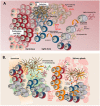Tertiary Lymphoid Structures: Autoimmunity Goes Local
- PMID: 30258435
- PMCID: PMC6143705
- DOI: 10.3389/fimmu.2018.01952
Tertiary Lymphoid Structures: Autoimmunity Goes Local
Abstract
Tertiary lymphoid structures (TLS) are frequently observed in target organs of autoimmune diseases. TLS present features of secondary lymphoid organs such as segregated T and B cell zones, presence of follicular dendritic cell networks, high endothelial venules and specialized lymphoid fibroblasts and display the mechanisms to support local adaptive immune responses toward locally displayed antigens. TLS detection in the tissue is often associated with poor prognosis of disease, auto-antibody production and malignancy development. This review focuses on the contribution of TLS toward the persistence of the inflammatory drive, the survival of autoreactive lymphocyte clones and post-translational modifications, responsible for the pathogenicity of locally formed autoantibodies, during autoimmune disease development.
Keywords: B-cells; autoantibodies; germinal center response; glycosylation; tertiary lymphoid structures (TLS).
Figures

References
Publication types
MeSH terms
Substances
Grants and funding
LinkOut - more resources
Full Text Sources
Other Literature Sources

